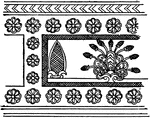Clipart tagged: ‘embellishment’

Assyrian Ornament
The purely conventional ornaments — the rosette, guilloche, and lotus-flower, and probably also…

Ornament at the foot of the wall from the Great Temple at Philæ
They are generally of smaller dimensions in the interior, so that the walls or columns of the same chamber…